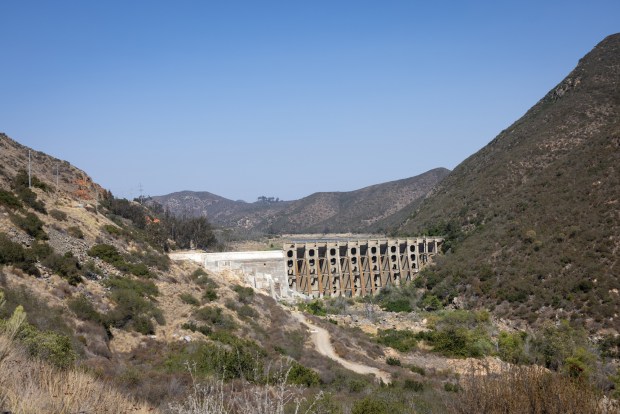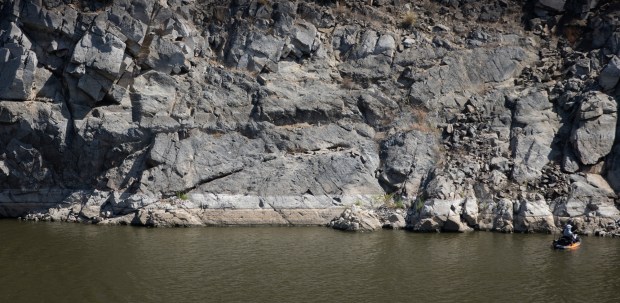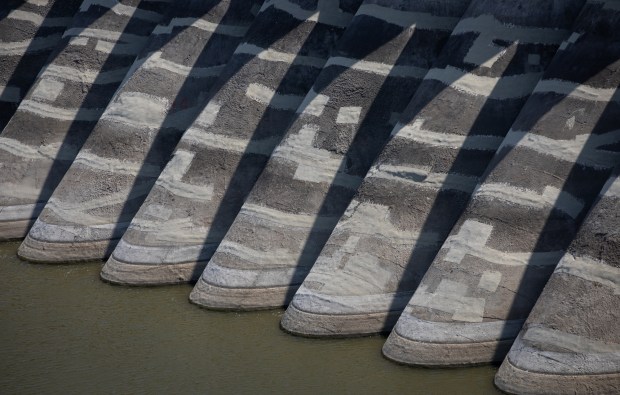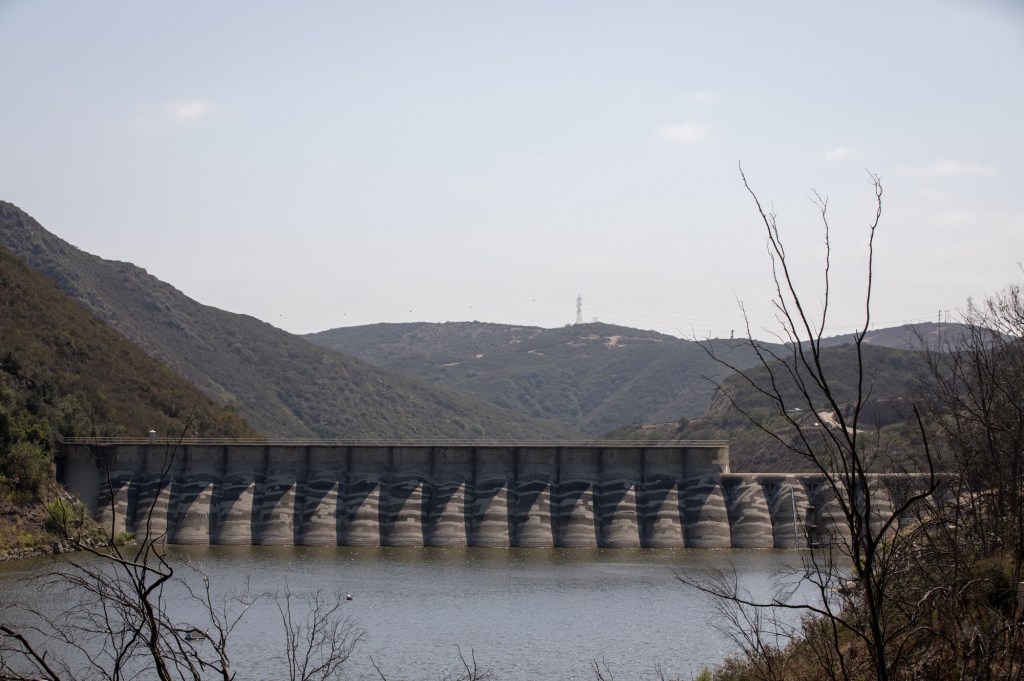San Diego is backing away from plans to rebuild the Lake Hodges Dam, thanks to ballooning cost estimates and the county water authority announcing it’s no longer willing to pay half the cost.
The state declared the dam unsafe two years ago, demanded the water level be lowered because of flood risk and ordered San Diego to accelerate efforts to rebuild the 106-year-old dam.
The city was on track to begin the rebuild by the end of 2029 — until a recent analysis determined the estimated costs had climbed from $275 million to somewhere between $474 million and $697 million.
That new 386-page analysis, which was conducted by an outside consultant, has prompted the cash-strapped county water authority to withdraw its support for the rebuild.
The city’s plan calls for the water authority to cover half the cost and for the other half to be split evenly between the city and the Santa Fe Irrigation District and San Dieguito Water District.
San Diego city officials plan to soon launch a comprehensive analysis of alternative — and less costly — solutions to the dam’s structural problems, a city spokesperson said this week.
“In light of the changed position of San Diego County Water Authority and the updated cost estimate, the city of San Diego will evaluate potential alternatives to full replacement to ensure that ratepayer dollars are used effectively while maintaining downstream safety,” said the spokesperson, Jennifer McBride.
Any potential rupture of the dam, which creates Lake Hodges by blocking the flow of the San Dieguito River, could flood Rancho Santa Fe, most of the San Dieguito River Valley and possibly Del Mar.
 Lake Hodges Dam on Wednesday, Aug. 13, 2025 in San Diego. (Ana Ramirez / The San Diego Union-Tribune)
Lake Hodges Dam on Wednesday, Aug. 13, 2025 in San Diego. (Ana Ramirez / The San Diego Union-Tribune)
The water authority defended its decision in a prepared statement Wednesday, contending its agreements with the city and the two water districts do not require the water authority to fund a full dam replacement.
“Building a new dam, as the city has proposed, falls outside the cost-share agreement,” the water authority said.
The water authority, which operates the Carlsbad Desalination Plant and buys imported water for local water districts, has been raising rates steeply in recent years because it has an oversupply of water.
In its statement, the water authority says this decision — like every decision it makes — is based on keeping rates as low as possible for local water customers.
The water authority says it has no plans to bail on its contractual obligations to the city and other agencies. It simply contends that paying for a new Lake Hodges Dam isn’t one of those obligations.
“We remain committed to working with all our member agencies to resolve this issue in a way that both maintains regional water security and protects working families across the county,” its statement said.
 A fisherman at Lake Hodges Dam on Wednesday, Aug. 13, 2025 in San Diego. (Ana Ramirez / The San Diego Union-Tribune)
A fisherman at Lake Hodges Dam on Wednesday, Aug. 13, 2025 in San Diego. (Ana Ramirez / The San Diego Union-Tribune)
Friends of Lake Hodges, a local nonprofit that advocates for safety and public access, said it is ready to support the city in its efforts to find a solution as quickly as possible.
Rhonda Farrar, the group’s leader, called the much higher new cost estimates “a big gulp moment for everyone.”
The city spokesperson didn’t say specifically which alternatives to a full dam replacement will be analyzed. For years, city officials have planned to build a replacement dam 100 feet downstream from the existing dam.
“All alternatives will be thoroughly evaluated,” McBride said. “The timeline for the technical alternative evaluation is still in development, but the city will share information as it becomes available.”
Last September, the city secured a $240.6 million federal loan for the dam replacement under the Infrastructure Investment and Jobs Act of 2021. It’s not clear whether that loan would apply to less ambitious projects.
In October 2023, San Diego announced it was moving up construction of the new Lake Hodges Dam from 2031 to 2029.
That announcement came shortly after the state declared the dam’s safety level “unsatisfactory” and demanded the city take action quickly — either make “major improvements” or ensure “the dam is replaced with a new one.”
The city typically would have already conducted an analysis of alternatives to full dam replacement, but officials moved quickly after the state’s action and skipped that step.
 Lake Hodges Dam on Wednesday, Aug. 13, 2025 in San Diego. (Ana Ramirez / The San Diego Union-Tribune)
Lake Hodges Dam on Wednesday, Aug. 13, 2025 in San Diego. (Ana Ramirez / The San Diego Union-Tribune)
The state also ordered the city to lower the water level in the reservoir, a move that has limited recreational opportunities including fishing, windsurfing and kayaking.
The move has also raised local water costs by limiting how much rainwater, which costs far less than imported water, the reservoir can store. Officials say 12 billion gallons have been released since the state mandated the lower level.
The lower level has also had financial consequences for the water authority — and ratepayers across the region.
The water authority, which owns half the water in the reservoir under its contractual agreement with the city, had been pumping much of its water into the Olivenhain Reservoir just west of Lake Hodges.
But the new Lake Hodges water level is lower than the water authority’s intake pipe that connects to the Olivenhain Reservoir, eliminating those transfers and the revenue they generate.
The water authority spent roughly $200 million on a pump station to make those transfers, before the lowering of the water level prevented using it. If no replacement dam is built, that money will arguably not have been well spent.
A water authority spokesperson said Wednesday that the inability to use the pump station is costing the authority $3 million per year, which puts more pressure on regional water rates.
Originally Published: August 14, 2025 at 5:00 AM PDT
